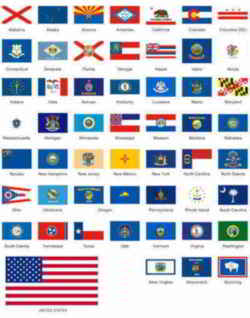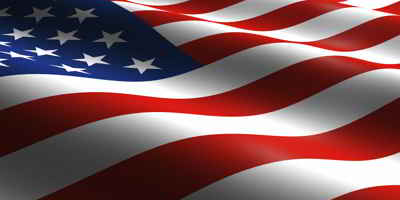Wisconsin State
Flag
Adopted in 1863.
The flag of the State of Wisconsin is a blue flag charged with the state coat of arms. Originally designed in 1863 when regiments from Wisconsin wanted a flag for battlefield use, it wasn't until 1913 that state statutes specified the design of the state flag.
In order to distinguish it from the many other blue U.S. state flags, Wisconsin's flag was modified in 1979 to add "Wisconsin" and "1848", the year Wisconsin was admitted to the Union. All Wisconsin state flags manufactured after May 1, 1981 were required to use this design.
Wisconsin State Flag
An official design for Wisconsin's state flag was initially provided by the legislature in 1863 at the request of Civil War regiments who wanted an official flag to fly during the war on the battlefield.
Until that date, a flag had not been adopted and Civil war regiments in the field were requesting flags. The legislature formed a 5 member joint select committee to report "a description for a proper state flag." This action resulted in the adoption of Wisconsin's flag. In 1913, the flag was changed, specifying a dark blue background with the state coat of arms centered at each side. That design remained unchanged until 1979, when legislature was asked to change the flag design so it would appear more distinctive and recognizable. They added the word "Wisconsin" and the statehood date in "1848" in white letters, centered respectively above and below the coat of arms.
All of the symbols on the flag represent a richness in Wisconsin natural resources, including the lakes and waterways, mineral riches under ground which provide useful products, and rich soil which provides abundance in crop production and food for people.
Wisconsin's state flag includes the Coat of Arms which represents many of our valued natural resources and the contributions of early pioneers to the state's development.
Starting at the top of a shield on a dark blue field is the state motto "Forward". Below it is the badger, which is the state animal, and sits above the shield. It represents the name given to the lead miners. A sailor and miner show that the people work on water and land. The shield in the center shows Wisconsin's support for the United States. In four sections surrounding the shield are representations of the states main industries: Agriculture, mining, manufacturing and navigation. The cornucopia and pile of lead represent farm products and minerals. The flag law was amended in 1979 to include the name of the state and the date of statehood.
Wisconsin Flag Law
Wisconsin Statutes & Annotations, Sovereignty, Jurisdiction and Civil Divisions of the State, Chapter 1.
Sovereignty, Jurisdiction and Civil Divisions of the State.
1. Sovereignty and jurisdiction of the state.
Section 1.08 State flag.
1.08 State flag. (1) The Wisconsin state flag consists of the following features:
(a) Relative dimensions of 2 to 3, hoist to fly.
(b) A background of royal blue cloth.
(c) The state coat of arms, as described under s. 1.07, in material of appropriate colors,
applied on each side in the center of the field, of such size that, if placed in a circle whose
diameter is equal to 50% of the hoist, those portions farthest from the center of the field
would meet, but not cross, the boundary of the circle.
(d) The word "WISCONSIN" in white, capital, condensed Gothic letters, one?eighth
of the hoist in height, centered above the coat of arms, midway between the uppermost part
of the coat of arms and the top edge of the flag.
(e) The year "1848" in white, condensed Gothic numbers, one?eighth of the hoist in
height, centered below the coat of arms, midway between the lowermost part of the coat of arms
and the bottom edge of the flag.
(f) Optional trim on the edges consisting of yellow knotted fringe.
(2) The department of administration shall ensure that all official state flags that are manufactured
on or after May 1, 1981 conform to the requirements of this section. State flags manufactured
before May 1, 1981 may continue to be used as state flags.
History: 1979 c. 286.

The Flags of the US.







